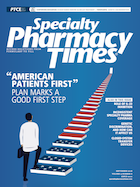Publication
Article
Specialty Pharmacy Times
A Blueprint for Change in Specialty Pharmacy
Author(s):
There is no doubt that aggressive actions must be taken throughout the US health care landscape to rein in spending on prescription drugs and help patients to access lifesaving therapies.
There is no doubt that aggressive actions must be taken throughout the US health care landscape to rein in spending on prescription drugs and help patients to access lifesaving therapies. Following the release in May of “American Patients First: The Trump Administration Blueprint to Lower Drug Prices and Reduce Out-of-Pocket Costs,” opinions have been divided among stakeholders across the industry on the potential positives and negatives of the proposal and how it will impact US health care in the long term.
The goals of the blueprint are to increase competition through the use of generics and biosimilars, improve drug price negotiation in Medicare Part B and Part D, incentivize manufacturers to decrease list prices, and bring much needed relief to consumer out-of-pocket spending. Despite differing opinions on how the overhaul will play out in the long term, there is no doubt that it will cause fundamental changes to health care in America.
In a statement on the drug pricing blueprint, Pharmaceutical Research and Manufacturers of America (PhRMA) pointed to difficulties caused by mis- aligned incentives in the supply chain that save money for pharmacy benefit managers but cause higher costs for patients. PhRMA expressed concerns that realigned incentives as part of the blueprint may help some patients but harm others.
“While some of these proposals could help make medicines more affordable for patients, others would disrupt coverage and limit patients’ access to innovative treatments,” PhRMA President and CEO Stephen J. Ubl said in a press release.
With these challenges in mind, in this issue we take a deep dive into how the drug pricing blueprint may affect the specialty pharmacy space. In his article on page 32, Council on Affordable Health Care President Joel White says that the blueprint is a promising first step in driving a system-wide shift toward value-based care. White says that the blueprint could prompt significant change by removing federal barriers that have blocked Medicare and Medicaid recipients from benefitting from promising value-based models.
Also in this issue, Dean Erhardt, MBA, president and CEO of D2 Consulting, discusses different trends to watch in the wake of the Trump blueprint in his article on page 16. As Erhardt notes, emerging and established manufacturers will need to keep pace with these trends to allow them to develop and execute a successful launch, distribution, and reimbursement strategy.
With change on the horizon and the specialty pharmacy landscape in flux as a result, it’s more important than ever to stay ahead of developing trends in health care, which remains our central focus in this journal and on our daily news website, specialtypharmacytimes.com. Follow us online, in print, and in our e-newsletters.
Sign up at specialtypharmacytimes. com/link/1306 to ensure your pharmacy is ready to flourish in these exciting but tumultuous times.







